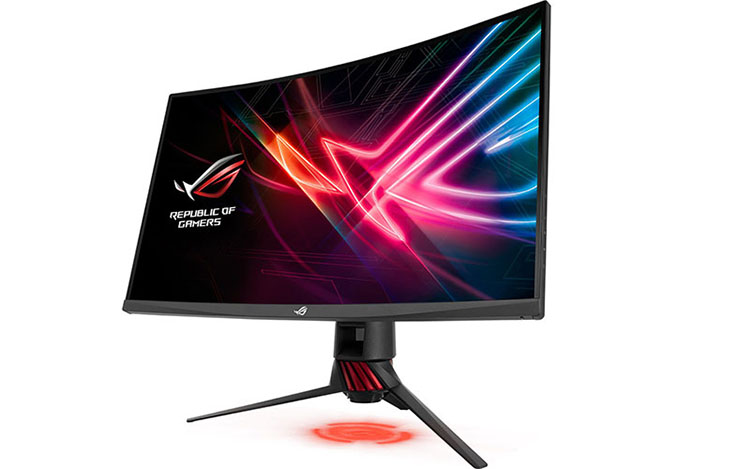Early Verdict
We like the XG32V; it offers a large, bright screen with excellent gaming performance, cool styling, and solid build quality for a reasonable price. But we missed a true sRGB color and 2.2 gamma option for more accurate with most of today’s video and gaming content. Still, it’s an impressive use of VA technology, with 3000:1 contrast and image quality superior to any IPS or TN monitor. Thanks to a 144Hz refresh rate and FreeSync, gaming is a pleasure. If you don’t mind the extra color, it makes for a compelling choice.
Pros
- +
Bright, saturated color
- +
Accurate DCI-P3 color out of the box
- +
144Hz & FreeSync with LFC
- +
OSD joystick
- +
Styling & Build quality
- +
Value
Cons
- -
No accurate sRGB option
- -
No 2.2 gamma option
- -
No motion blur reduction
Why you can trust Tom's Hardware
Features & Specifications
Curved monitors have created a solid niche for themselves in today’s computer display market. They work well for general tasks, but gaming is where the really shine. The immersive effect they provide just can’t be replicated with a flat screen. Most of these panels come in a 21:9 ultra-wide aspect ratio, but a few models stick with the more-common 16:9 shape. For some users, this makes them more versatile.
Asus’ Republic of Gamers line is all about gameplay. The hardware is designed for no-holds-barred (and sometimes price-no-object) performance. We’ve looked at many of the line's high-refresh-rate monitors and found that they generally live up to the hype. It was a surprise, then, when we learned Asus would be adding 16:9 curved screens to the series. The first of those we’re looking at is the ROG Strix XG32V. It’s a 31.5” VA panel with QHD (2440x1400) resolution, and 1800R curvature, DCI-P3 color support, and a 144Hz refresh rate with FreeSync (AMD's screen-smoothing variable refresh tech).
Specifications
Asus has endowed the XG32V with several interesting features. First up is the 16:9 1800R VA panel, which is somewhat unusual among gaming monitors. Typically, these screens are either large and flat, or curved and wide. Here, we have a relatively subtle 1800mm radius curve, coupled with a traditional 16:9 aspect ratio. Thanks to a 31.5” diagonal size, the monitor has no problem filling the viewer’s peripheral vision, and the extra pixel height helps block out surrounding distractions even more effectively. This monitor might be considered a good alternative to the 38” ultra-wide behemoths that not only take up a lot of desktop space, while demanding ultra-premium prices.
Speed comes in the form of a 144Hz refresh rate, with variable-refresh FreeSync operation down to 48Hz. The wide 96Hz refresh range is accompanied by Low Framerate Compensation, which doubles frames when the action drops below 48fps. Basically, that means your games should never suffer from screen tearing, even at extremely low frame rates. Of course, so long as you have a reasonably powerful graphics card, you won’t have much to worry about there since there are fewer pixels to move about. The QHD resolution here is a performance sweet spot. Premium video cards can top 100fps with ease while budget-oriented boards can maintain 60fps. You give up a bit of pixel density over a 27” monitor with the same resolution, but the 93ppi here will still render fine detail with clarity.
For the style-conscious, Asus has added Aura Sync. This feature manipulates the LED lighting on the base and back of the monitor with various colors and effects. Aura Sync means you can match the light show on your screen with those in your case--provided you have a compatible Asus motherboard. If you’re looking for a theatrical experience to pair with your favorite game, Aura Sync has you covered.
The final piece of the feature puzzle is Asus' claim of 125% sRGB color. That sounds suspiciously like a DCI-P3 color gamut to us. We’ll be exploring that one during the testing phase. The Strix XG32V looks impressive both on paper and in its physical presence. Let’s take a look.
Packaging, Physical Layout & Accessories
The Strix XG32V is a large monitor and it comes in an appropriately-sized box with ample protection. Our sample arrived in perfect shape, despite a few dents in the carton. The upright is permanently attached to the panel, thanks in part to the integrated lighting system. But VESA mount users will have to look elsewhere for a gaming monitor. The base attaches with a single captive bolt, then you snap on the lighting cover with one of its three lenses (more on that below).
Get Tom's Hardware's best news and in-depth reviews, straight to your inbox.
Asus includes HDMI, DisplayPort, and USB 3.0 cables in the box. The power supply is external and comes in its own small box that looks a lot like an Apple TV. You also get a printed quick-start guide and a CD with Aura Sync software and the user manual.
Product 360
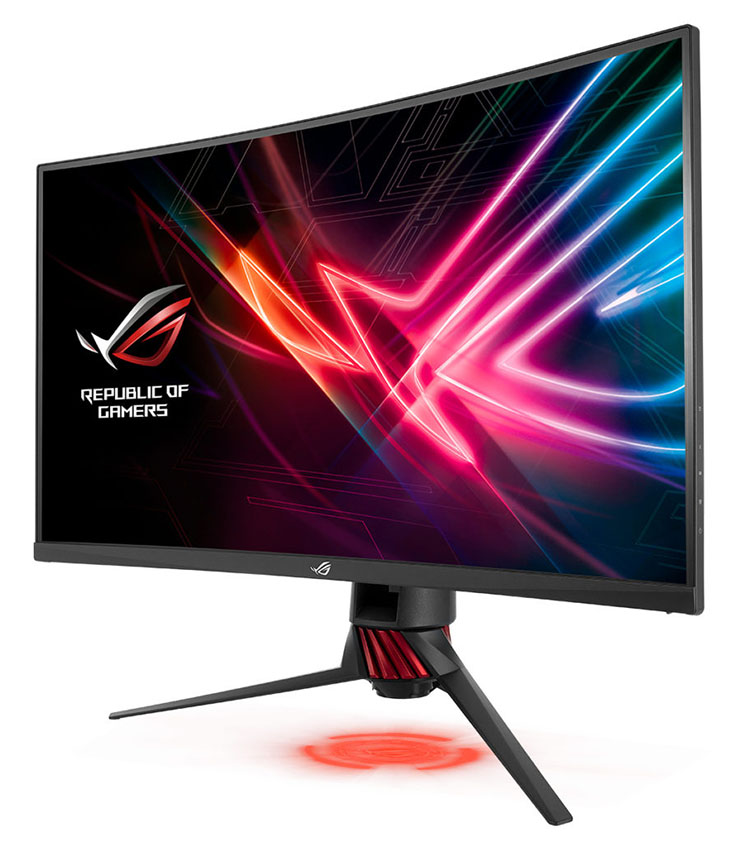
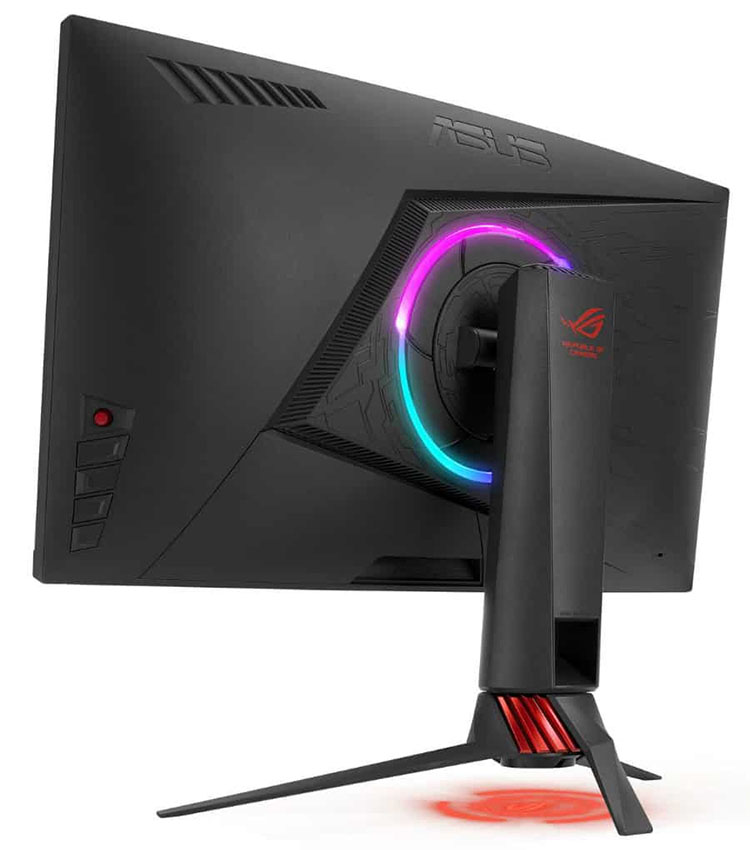
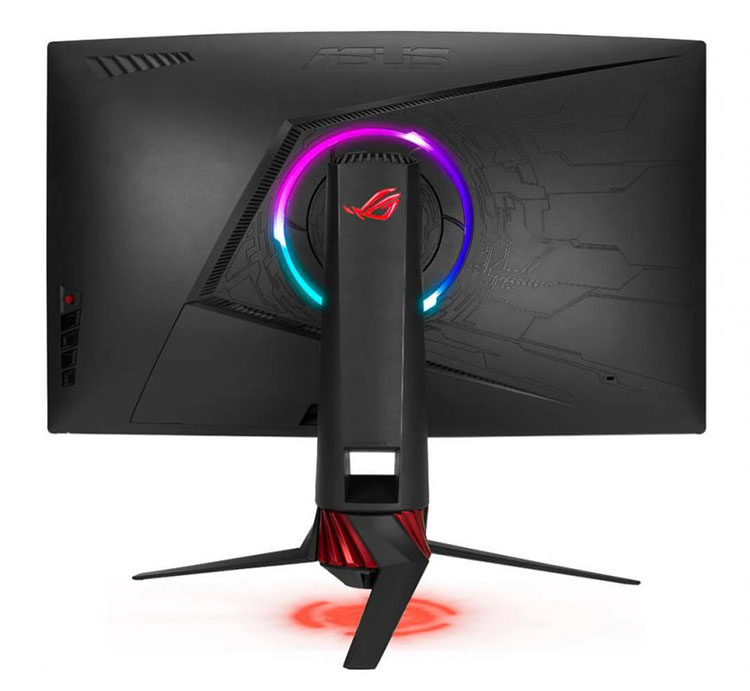
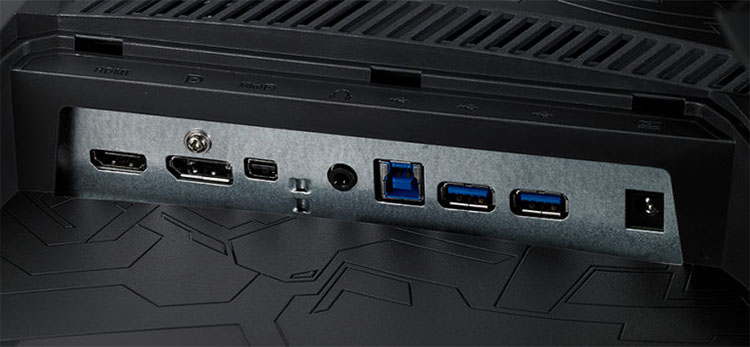
Once the XG32V is up and running, your eyes will be immediately drawn to the lighting effect coming from the base. Asus has included three lenses that project two different logos, or simply a soft glow if you prefer. The effect is controlled by both the OSD and Aura Sync software. The latter can be used to coordinate the light show between the monitor and other supported ROG hardware like case lighting or RAM sticks. LEDs are also found in back, around the upright’s attachment point. That, coupled with the spaceship-plating style we’ve seen in other ROG monitors, sets Asus apart from other brands. You’ll know immediately what kind of monitor you’re looking at.
The curve radius is 1800mm, which is relatively subtle compared to other gaming screens. But it's appropriate for the 16:9 aspect ratio in that it provides a nice wrap-around effect without image distortion. Pixel density is a tad low at this size, but clarity is not an issue. The picture is sharp and clear thanks to an optically-perfect anti-glare layer.
The bezel is very narrow at the top and sides, but a little wider at the bottom. Controls are found around back on the lower-right, and consist of four large buttons and a joystick. OSD navigation is simple and intuitive, though the power key feels the same as the other controls, making it a little too easy to turn off the XG32V inadvertently.
In the rear-panel photo, you can’t see the input panel because it’s hidden by a snap-on cover, which completes the chassis’ shape. Cables exit through a small hole and can be threaded through the upright for tidiness. Connections consist of a single HDMI 2.0 port, two v1.2 DisplayPorts (one is mini), a 3.5mm analog audio output, and two USB 3.0 downstream ports with one upstream. You’ll need to connect the USB cable to your PC to make Aura Sync work.
MORE: Best Gaming Monitors
MORE: Best Professional Monitors
MORE: How We Test Monitors
MORE: How To Choose A Monitor
MORE: All Monitor Content

Christian Eberle is a Contributing Editor for Tom's Hardware US. He's a veteran reviewer of A/V equipment, specializing in monitors. Christian began his obsession with tech when he built his first PC in 1991, a 286 running DOS 3.0 at a blazing 12MHz. In 2006, he undertook training from the Imaging Science Foundation in video calibration and testing and thus started a passion for precise imaging that persists to this day. He is also a professional musician with a degree from the New England Conservatory as a classical bassoonist which he used to good effect as a performer with the West Point Army Band from 1987 to 2013. He enjoys watching movies and listening to high-end audio in his custom-built home theater and can be seen riding trails near his home on a race-ready ICE VTX recumbent trike. Christian enjoys the endless summer in Florida where he lives with his wife and Chihuahua and plays with orchestras around the state.
-
Ninjawithagun So many things that are not in favor of this monitor, which IMHO is too little, too late and uses 'last-gen' technologies. Where are the OLED HDR G-Sync 165-200Hz monitors of the same or even higher resolutions? And the 16:9 aspect ratio is already losing market share quickly to the 21:9 monitors as more and more people transition over. This monitor is just old news being sold as something new.Reply -
Ninjawithagun Reply20788821 said:Asus' curved 32” ROG Strix XG32V impresses, thanks to its VA panel with 2560x1440 pixels, a 1800mm curve radius, DCI-P3 color, and a 144Hz refresh rate with FreeSync down to 48Hz.
Asus ROG Strix XG32V Curved Gaming Monitor Review: Big, Smooth & Colorful : Read more
VA panels are notorious for ghosting. I have yet to see a single VA panel monitor not have this issue. The DCI-P3 color gamut is a nice feature to have. I still heavily prefer G-Sync 2 over FreeSync 2 not matter what as the overall gaming experience is still superior with Nvidia cards, albeit is subject to one's preferences over the long term. G-Sync also has a much better lower dynamic refresh threshold of 30Hz versus 48Hz of the FreeSync 2. Overall, the refresh rate supported by the XG32V are great, but again are ruined by the ghosting caused by the use of a VA panel. And the absence of HDR is an absolute fail IMHO.
-
Xenocrates Ninja, look at the price tag of this, and compare it to the price tag of other monitors with the sort of specs you're talking about. The 4K 27 inch Swift from Asus is nearly twice the price, while the same approximate size dell Monitor, the now canceled Dell UP3017Q which was only 120hz, was priced at 5000 dollars, and didn't provide enough margin to be worth fixing the image quality issues.Reply
It's not cutting edge, sure. But it's a good product. I personally wouldn't go much above 600$ for a monitor. After all, I can buy three decent quality 1080p screens for that price. But if all people make are super monitors with four digit price tags, and cheap crap, that's what people will buy. But a nice middle ground, with monitors between 400 and 800, helps build a healthy market, because those supermonitors, once the cutting edge has moved on, can move to higher bulk, and trickle down, without us needing to wait for the prices to drop quite as much to get the features. -
Ninjawithagun Reply20789072 said:Ninja, look at the price tag of this, and compare it to the price tag of other monitors with the sort of specs you're talking about. The 4K 27 inch Swift from Asus is nearly twice the price, while the same approximate size dell Monitor, the now canceled Dell UP3017Q which was only 120hz, was priced at 5000 dollars, and didn't provide enough margin to be worth fixing the image quality issues.
It's not cutting edge, sure. But it's a good product. I personally wouldn't go much above 600$ for a monitor. After all, I can buy three decent quality 1080p screens for that price. But if all people make are super monitors with four digit price tags, and cheap crap, that's what people will buy. But a nice middle ground, with monitors between 400 and 800, helps build a healthy market, because those supermonitors, once the cutting edge has moved on, can move to higher bulk, and trickle down, without us needing to wait for the prices to drop quite as much to get the features.
It has nothing to do with price. I am strictly speaking about available technologies. It has been proven time and time again that even the most expensive, best features, best spec'd monitors sell out immediately. I for one am willing to pay more for more, but am unwilling to pay less for the same old tech we have had for several years. Ironically, even my budget minded friends who PC game are frustrated that monitors have ceased to advance along in technologies that have been available in TVs for years. OLED (or similar tech), HDR (Dynamic or static, either would be welcome), high variable/dynamic refresh rates, and a single monitor solution having all of these technologies is well overdue in the monitor market. Remember CES 2017 where several manufactures said they would have these monitors to market by end of 2017? It's now Spring 2018 and these monitors are nowhere to be found. Sad.
-
Co BIY Something like this is on my list. Iprefer the 16:9 ratio for my computer monitor.Reply
I have to think that graphics card availability is hurting new monitor sales. What is the point of FreeSync when AMD cards are 100% unavailable? (not that nVidia cards are more available). -
Ninjawithagun I prefer 21:9 as I can choose whenever and whatever I want to run 16:9 should I feel the urge to do so. But, for gaming there is no substitute. 21:9 is absolutely amazing when gaming or watching a movie!Reply -
singemagique I have multiple panels at my desktops (at least 2 at each) and prefer the 16:9, this isn't a bad deal considering the price. While 21:9 may be better for movies, I much prefer to watch my films on my television with proper surround sound.Reply -
cryoburner Reply
I really don't think this is actually true. Using Newegg's search tools to look for curved screens (new condition with Newegg as the seller to avoid duplicates) they appear to currently be selling 30 models of curved 16:9 screens, and just 29 models of curved 21:9 screens. That is pretty much evenly split between ultra-wide and wide aspect-ratios, with the standard 16:9 aspect ratio technically having slightly more options available when it comes to curved monitors.20788821 said:Most of these panels come in a 21:9 ultra-wide aspect ratio, but a few models stick with the more-common 16:9 shape. -
cryoburner Reply
The last I checked, OLED still wasn't really suitable for screens that will be left on for many hours a day. The problem is that OLED degrades relatively quickly. If an OLED screen is left on for 8 hours a day, it can lose around 50% of its brightness after just 5 years, with blue degrading faster than the other colors, potentially resulting in the color balance getting shifted over time. TV and phone screens are typically only on for a few hours or less a day, so that might not be as much of a problem for them, but many computer screens tend to be left on for much longer lengths of time.20789002 said:So many things that are not in favor of this monitor, which IMHO is too little, too late and uses 'last-gen' technologies. Where are the OLED HDR G-Sync 165-200Hz monitors of the same or even higher resolutions? And the 16:9 aspect ratio is already losing market share quickly to the 21:9 monitors as more and more people transition over. This monitor is just old news being sold as something new.
...G-Sync also has a much better lower dynamic refresh threshold of 30Hz versus 48Hz of the FreeSync 2.
And this screen shouldn't need G-Sync, since it has the industry standard Adaptive-Sync, otherwise known as FreeSync. Complain to Nvidia for why they still only support their proprietary version of the technology, while refusing to support the open standard that's part of the official DisplayPort specification. Microsoft announced just the other day that the Xbox One will be getting Freesync support soon, and it probably won't be long before the Playstation adds it as well. Screen manufacturers need to buy an extra, expensive chipset from Nvidia to support G-Sync, whereas FreeSync is supported by standard DisplayPort hardware and doesn't cost extra to add. Nvidia needs to support the open standard that everyone else is using, not the other way around. It seems likely that Nvidia may add support for FreeSync eventually, and there's not likely any reason why they couldn't enable it for their cards today, but they are holding out as long as they can to sell overpriced monitor chipsets and encourage people to stay locked into their hardware ecosystem.
And as for the "lower dynamic refresh threshhold", that's not entirely accurate, since Low Framerate Compensation (LFC) allows Freesync to continue operating at lower frame rates. Below 48fps, it will simply keep the same image up for additional frames at a higher refresh rate. For example, at 47fps, it might display the image twice at 94Hz, and at 30fps, it might display the image twice at 60Hz to keep adaptive sync active at frame rates below what the hardware natively supports.
The resolution and frame rate seem great for this monitor. High refresh rates are good to have, but you start seeing diminishing returns past a certain point. I doubt anyone could notice any significant difference between gaming at 144Hz and at 165 Hz. And 144Hz is already pushing the limits of what VA and IPS panels are capable of. At higher refresh rates than that, you're pretty much stuck with outdated TN panel technology, which aside from having faster pixel response times, is worse than the other screen technologies when it comes to actual image quality. And that's assuming your CPU can even keep up with frame rates in excess of 144Hz, which won't be the case in most recent demanding titles, even with the highest end CPUs currently available.
2560x1440 is also a good resolution, and 31.5" is a decent size for that. Higher resolutions will be harder to push at high frame rates in recent games, even on enthusiast-level cards. And if someone really wants to run their game at a 21:9 aspect ratio, there's no reason why they can't on a 2560x1440 screen. Setting the resolution to 2560x1080 on this screen with a bit of letterboxing at the top and bottom should result in an area equivalent in size to a 30" 21:9 monitor.
